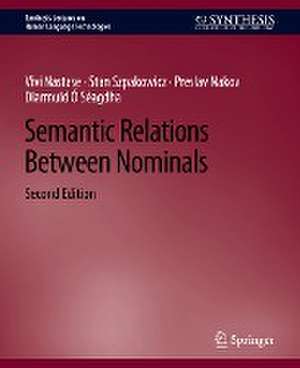Semantic Relations Between Nominals, Second Edition: Synthesis Lectures on Human Language Technologies
Autor Vivi Nastase, Stan Szpakowicz, Preslav Nakov, Diarmuid Ó Séagdhaen Limba Engleză Paperback – 8 apr 2021
Din seria Synthesis Lectures on Human Language Technologies
- 20%
 Preț: 223.34 lei
Preț: 223.34 lei - 20%
 Preț: 282.54 lei
Preț: 282.54 lei - 20%
 Preț: 277.60 lei
Preț: 277.60 lei - 20%
 Preț: 227.81 lei
Preț: 227.81 lei - 20%
 Preț: 227.29 lei
Preț: 227.29 lei - 20%
 Preț: 227.12 lei
Preț: 227.12 lei - 20%
 Preț: 274.48 lei
Preț: 274.48 lei - 20%
 Preț: 479.30 lei
Preț: 479.30 lei - 20%
 Preț: 224.65 lei
Preț: 224.65 lei - 20%
 Preț: 415.47 lei
Preț: 415.47 lei - 20%
 Preț: 357.06 lei
Preț: 357.06 lei - 20%
 Preț: 388.17 lei
Preț: 388.17 lei - 20%
 Preț: 226.64 lei
Preț: 226.64 lei - 20%
 Preț: 478.36 lei
Preț: 478.36 lei - 20%
 Preț: 224.50 lei
Preț: 224.50 lei - 20%
 Preț: 334.38 lei
Preț: 334.38 lei - 20%
 Preț: 225.99 lei
Preț: 225.99 lei - 20%
 Preț: 225.67 lei
Preț: 225.67 lei - 20%
 Preț: 166.43 lei
Preț: 166.43 lei - 20%
 Preț: 424.05 lei
Preț: 424.05 lei - 20%
 Preț: 358.95 lei
Preț: 358.95 lei - 20%
 Preț: 225.67 lei
Preț: 225.67 lei - 20%
 Preț: 227.12 lei
Preț: 227.12 lei - 20%
 Preț: 270.04 lei
Preț: 270.04 lei - 20%
 Preț: 537.06 lei
Preț: 537.06 lei - 20%
 Preț: 225.67 lei
Preț: 225.67 lei - 20%
 Preț: 228.13 lei
Preț: 228.13 lei - 20%
 Preț: 353.61 lei
Preț: 353.61 lei - 20%
 Preț: 227.12 lei
Preț: 227.12 lei - 20%
 Preț: 422.25 lei
Preț: 422.25 lei - 20%
 Preț: 270.69 lei
Preț: 270.69 lei - 20%
 Preț: 354.92 lei
Preț: 354.92 lei - 15%
 Preț: 519.19 lei
Preț: 519.19 lei - 20%
 Preț: 226.97 lei
Preț: 226.97 lei - 20%
 Preț: 384.53 lei
Preț: 384.53 lei - 20%
 Preț: 226.64 lei
Preț: 226.64 lei - 20%
 Preț: 358.04 lei
Preț: 358.04 lei - 20%
 Preț: 330.75 lei
Preț: 330.75 lei - 20%
 Preț: 327.95 lei
Preț: 327.95 lei - 20%
 Preț: 299.48 lei
Preț: 299.48 lei - 20%
 Preț: 228.28 lei
Preț: 228.28 lei - 20%
 Preț: 382.39 lei
Preț: 382.39 lei - 20%
 Preț: 418.59 lei
Preț: 418.59 lei - 20%
 Preț: 326.13 lei
Preț: 326.13 lei - 20%
 Preț: 271.86 lei
Preț: 271.86 lei
Preț: 503.01 lei
Preț vechi: 628.76 lei
-20% Nou
Puncte Express: 755
Preț estimativ în valută:
96.26€ • 104.53$ • 80.86£
96.26€ • 104.53$ • 80.86£
Carte tipărită la comandă
Livrare economică 23 aprilie-07 mai
Preluare comenzi: 021 569.72.76
Specificații
ISBN-13: 9783031010507
ISBN-10: 3031010507
Pagini: 220
Ilustrații: XVI, 220 p.
Dimensiuni: 191 x 235 mm
Greutate: 0.41 kg
Ediția:2
Editura: Springer International Publishing
Colecția Springer
Seria Synthesis Lectures on Human Language Technologies
Locul publicării:Cham, Switzerland
ISBN-10: 3031010507
Pagini: 220
Ilustrații: XVI, 220 p.
Dimensiuni: 191 x 235 mm
Greutate: 0.41 kg
Ediția:2
Editura: Springer International Publishing
Colecția Springer
Seria Synthesis Lectures on Human Language Technologies
Locul publicării:Cham, Switzerland
Cuprins
Preface to the Second Edition.- Introduction.- Relations Between Nominals, Relations Between Concepts.- Extracting Semantic Relations with Supervision.- Extracting Semantic Relations with Little or No Supervision.- Semantic Relations and Deep Learning.- Conclusion.- Bibliography.- Authors' Biographies.- Index.
Notă biografică
Vivi Nastase holds a Ph.D. from the University of Ottawa. A research associate at the Univer sity of Stuttgart, she works mainly on lexical semantics, semantic relations, knowledge acquisi tion, and language evolution.Stan Szpakowicz holds a Ph.D. from Warsaw University, and a D.Sc. from the Institute of Informatics, Polish Academy of Sciences. Now an emeritus professor of Computer Science at the University of Ottawa, he has dabbled in NLP since 1969. His interests in the past several years include semantic relations and lexical resources.Preslav Nakov holds a Ph.D. from the University of California, Berkeley. He leads the Tanbih mega-project, developed in collaboration with MIT, which aims to limit the impact of fake news, propaganda, and media bias.Diarmuid Ó Séagdha holds a Ph.D. from the University of Cambridge. He works for Apple, and is a Visiting Industrial Fellow at the UC’s NLIP Research Group. His interests revolve around the application of machine learning techniques to semantic processing tasks.
